Lloyds Sales Application Flow
My role: I collaborated closely with a service designer over three months. We worked with two wider teams of (14) customer-facing colleagues in sales. I helped to research, observe, facilitate workshops, create storyboards and user persona, analyse findings and come up with solutions.
Pain points:
There were a number of complaints about the sales application flow from both customers and sales colleagues
There was a high drop off rate of customers during this flow
The flow was not customised based on customers industry or needs
Specific painpoints about the flow were discovered through the series of workshops
Customers and colleagues did not feel like they were interacting with each other for the best onboarding experience
Getting to the actual cost quote took a long time with unneeded or complex questions
The journey was not customised or based on customer/business needs for different industries or business types
Tags: #UX Design #Workshops #Sales Application Journey #Analysis #Service Design
SCOPE
This project is to improve the sales call flow journey after a customer has had their business account application verified for both the customer-facing colleagues and the customers themselves.
Once the application has been made, customers call our customer-facing colleagues in sales to apply to Cardnet ( Lloyds’ taking payment platform) to help them choose a suitable subscription/contract and device plan by giving them all the information that they need and some quotes to think about. This improvement is to make sure that the needs of the customer and Lloyds colleagues will be met more effectively through the application journey.
THE PROBLEM
Problem statement:
Customers who were applying for the Cardnet platform had to go through an application that was completed via a call with the sales team. This is a problem as there have been complaints from both the customers and the customer-facing colleagues about issues within the call flow including length and complexity. When applications are not completed or give a negative experience to both user groups, there are fewer completed applications and targets being met - therefore ending in business risks of losing revenue and customers for Cardnet.
The journey included 16 steps of pages with multiple questions with varying degrees of importance and sensitivity that a customer would need to complete while on a phone call with the sales team. The calls could easily take over 15 minutes to go through with customer drop-offs. These questions would then be sent through to find out the eligibility of the business in the application, confirming things like addresses, identity and turnover- and that it complies with industry regulations, for example, any anti- fraud or anti-money laundering concerns.
PROCESS
First of all, our team had been looking at ways of improving data and services throughout the bank. We interviewed various parts of the bank to find out where there were frustrations with data. From this research, we came across customer complaints and took a deep-dive into the different categories of complaints and where they were most found.
We managed to find a gap of opportunity within the onboarding application journey with the sales team. First we contacted the manager of the sales team, the product owner and two stakeholders for micro and small businesses (both with an annual turnover of less than £50,000) . We were able to point out where the data lacked, and present complaints and insights that had been received from the customer side to the complaints team about the application/sales journey.
The 14 colleagues that we worked with were two groups of colleagues, diverse in backgrounds and age. For this purpose, I will name them Team A and Team B. Team A were a group of colleagues that had worked for the sales team for over 1 year. Team B were a group of colleagues that worked with Micro businesses and had worked for the sales team for 3 months to 1 year.
Although the project had started small, we realised the impact that improving and optimising the call flow would have on our colleagues and customers. We created a proposal for further research and the workshops with the manager and stakeholders who were thankfully able to see the positive benefits of making this a larger project.
Team A excelled in customer handling, contrasting Team B’s application experience. The team was at ease, and confident in sharing insights, pain points, and group contributions. I conducted observation sessions/workshops for detailed insights from both teams at various journey points. We then observed and interviewed Team B at their head office for call journey insights, who were a quieter group that stuck to the script.
OBSERVATIONS
While naturalistic observing the customer-facing colleagues in their role over two days, we were able to pick up on some behaviours and frustrations. We shadowed the colleagues and remained observant, however towards the end, I started to ask some questions about how they worked. Below are some observations that were made:
The amount of unsuccessful calls that were made over two days was a bit alarming. This got us to start thinking about ways in which we could improve the call flow and make it more desirable for the customer to start (and complete) the sales call.
Through the observations we wanted to be able to split the different segments of the call flow so it would be easier to focus on. We did a card sorting exercise with both teams to play around and see their preferred flow, but also managed to come up with a way to split the call flow into seven segments.
WORKSHOP STRUCTURE
-
The teams were diverse in age and gender. This was to put them at ease in the workshop setting. The icebreaker was to share a time when they had given great customer service and what they thought the customer looked like. This allowed me to get an idea of the different kinds of customers that they served and to hear interesting anecdotal situations and their solutions.
-
We wanted to try and define the North Star at the beginning of the workshop to see how the workshop results would change/evolve this. We wanted to see what success looked like to the groups based on their first thoughts and align this. Notes were taken on sticky notes and stuck below to reflect on at the end of the workshop. This helped to give some clarity on what was to be expected.
-
I placed coloured paper on the wall with the title of the seven segments of the call journey : 1) Post-call preparation, 2) Verification and business eligibility, 3)Understanding needs/warming up, 4) Product/Pricing conversations, 5) Review and confirmation, 6) Sign the documents, 7) Follow up conversation. Team A and Team B were split into two groups each and stuck sticky notes onto the respective segment that highlighted frustrations and pain points as well as elements in that segment that worked well (for themselves or the customer). This was then presented and discussed to the group.
-
We wanted to think about the kind of customers that usually called in to submit applications and that they commonly interacted with. The teams came up with the following: New to business (a business that has just started), side hustler, school, charity, seasonal client (only operates at a certain time in the year) and tech savvy switcher (a client who is looking to switch providers and is knowledgeable about all the ins and outs).
-
To break the ice after the lunch break, we asked everyone to fold their pages in half and come up with really bad solutions to elements that had been highlighted in the call journey in 4 minutes (30 second ideas). This was a great way to generate ideas and to get the colleagues familiar with the process of Crazy eights. We followed this with repeating the exercise but more realistic and capable solutions that they may have.
-
Using the solutions from exercises 3 and 5, we put everything on sticky notes and displayed them everywhere. We got the group to start to see similarities within the solutions and start to categorise them together. Once the categories were made, everyone was given 3 dot stickers which they placed on the sticky note solutions that they thought would be the most helpful.
-
The final exercise was to role play to help visualise some of the solutions to enhance user experience. This allowed the teams to act and react naturally as they worked. We separated the group in half: one as the customer and one as the customer-facing colleague. Each team came up with a script using one of the hypothetical solutions. We used a burger king crown to symbolise the customer facing colleague to lighten the exercise and highlight that this was a fun activity.
-
We went over the solutions and ideas that had been generated over the session. We revisited the North Star and were able to rethink and prioritise certain ideas over others. The workshops were extremely successful in many ways, allowing the teams to voice their opinions and figure out some sub-conscious ideas that would help. We also sked participants to rank and prioritize the identified features through voting exercises and listed out their next steps to get to their MVP.
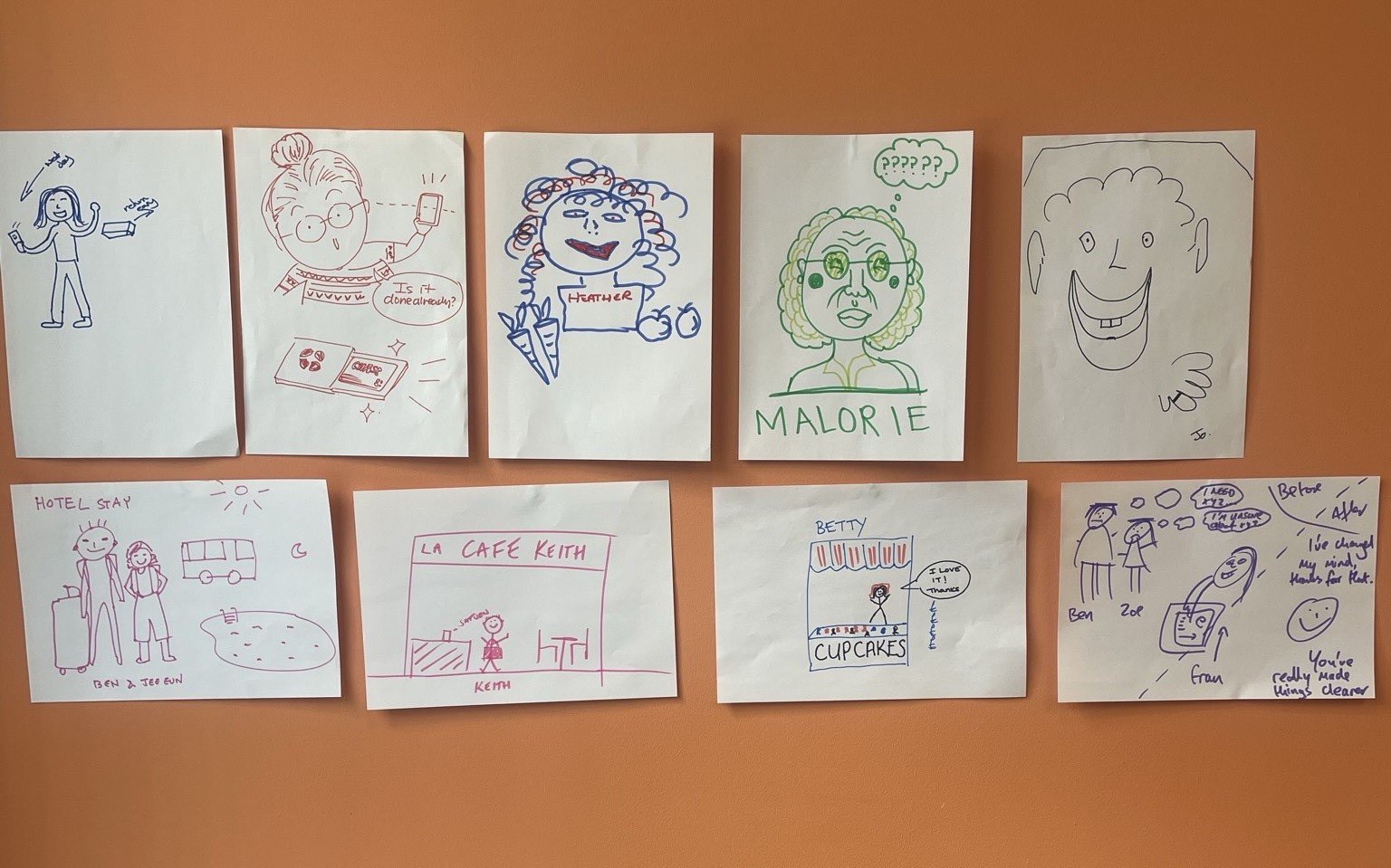
Ice breaker- We initiated the process by helping participants create detailed user personas as an ice breaker using the prompt "tell us about the last time you rang up and received amazing customer service".

Ice breaker- This step deepened our understanding of our target audience's needs and preferences from their experiences.
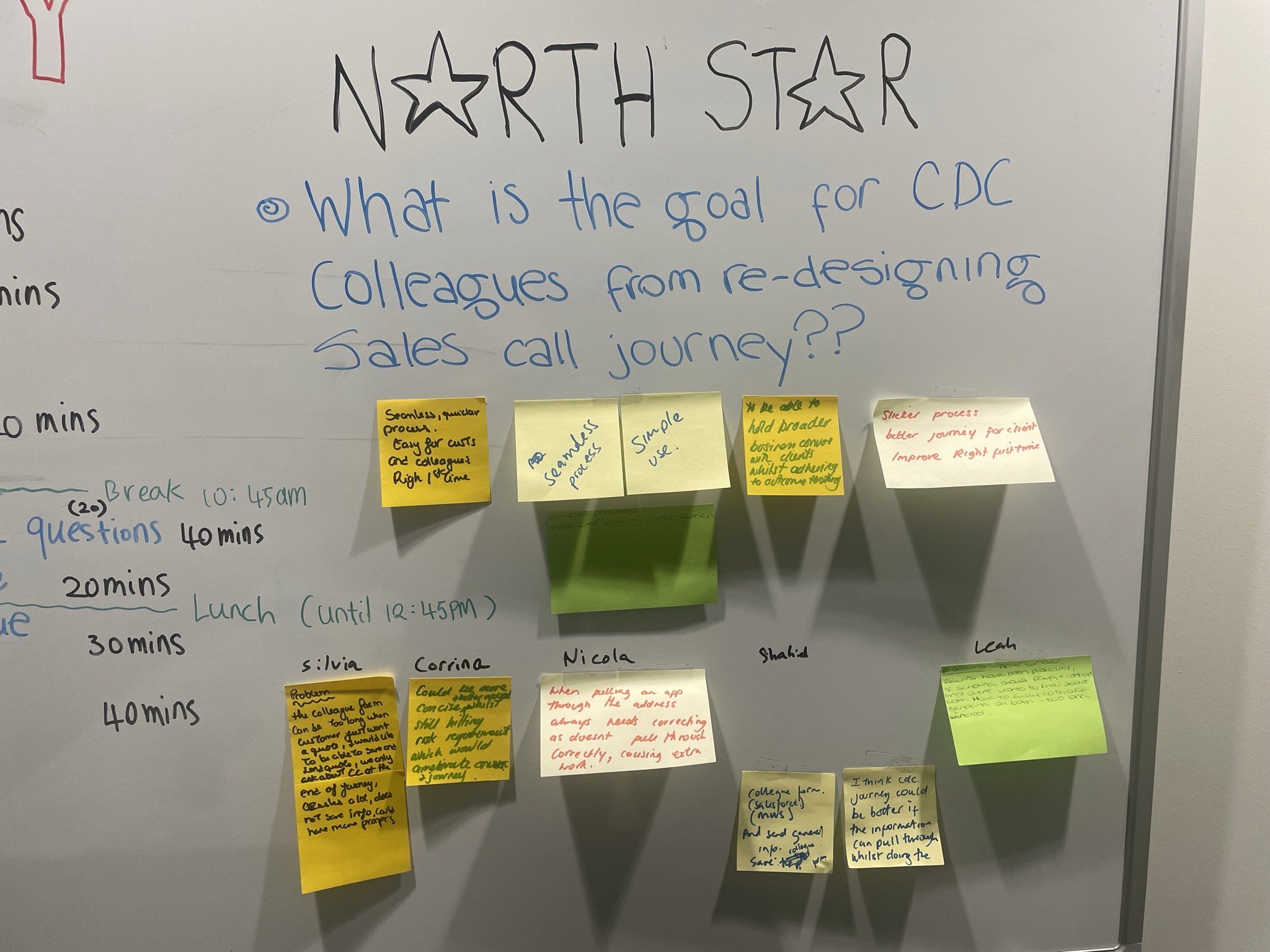
North star- "What is the goal for CDC colleagues from re-designing the sales call journey flow?"
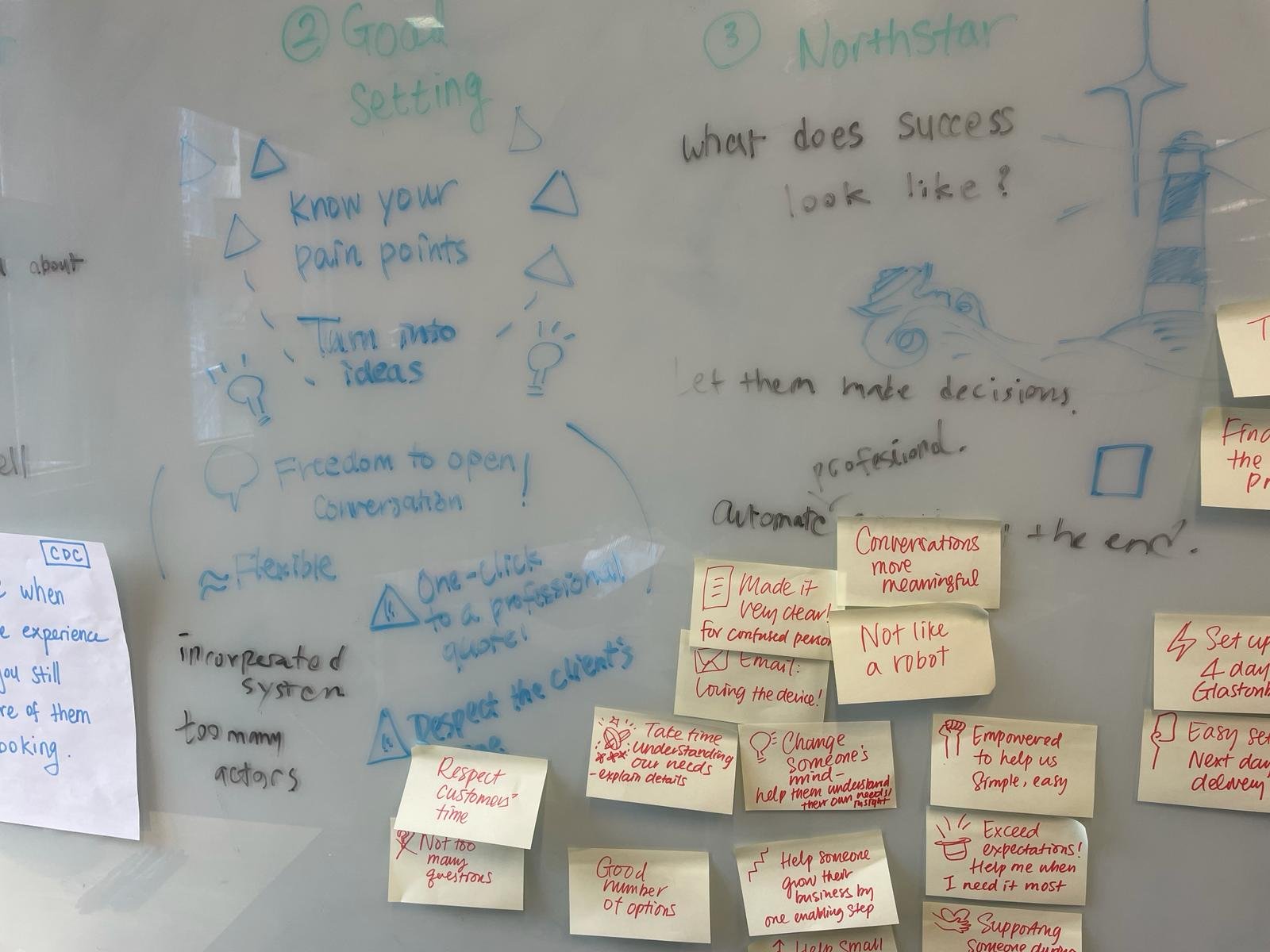
North star- Setting the scene for the workshop. Wanted to find out about their thoughts and frustrations to develop later on.
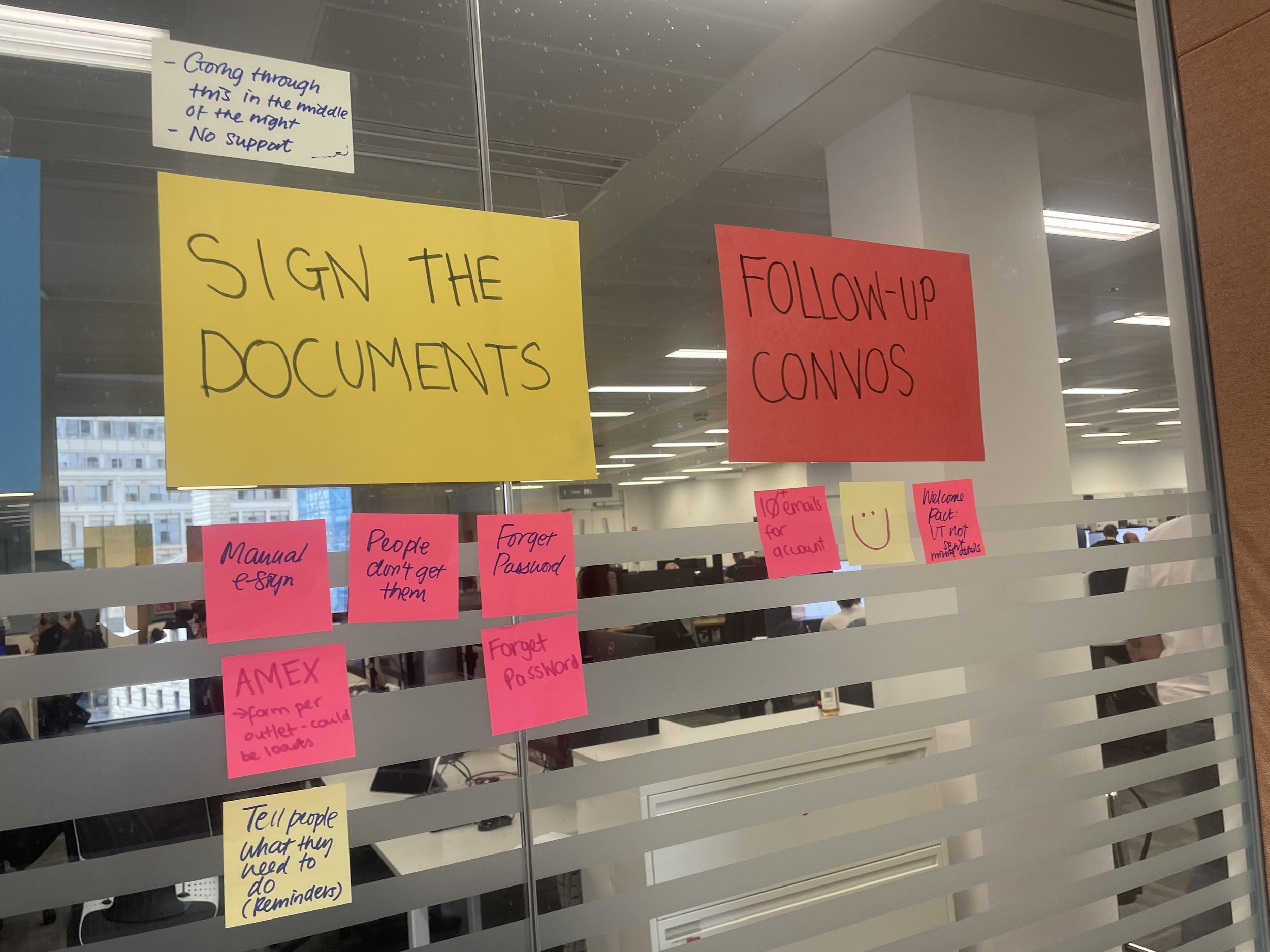
Customer journey map: Mapped out the complete user journey, pinpointing key touchpoints crucial to the application process.

Customer journey map- This illuminated areas for improvement and innovation using sticky notes under each step of the application form.

Brainstorming- we took the sticky notes off of the customer journey map and made them into an affinity map of categories/similar ideas.

Brainstorming & dots- Participants then delved into prototyping and brainstorming solutions, focusing on pain points and ideas.

Brainstorming & dots- This collaborative effort helped unearth common themes and potential solutions and every colleague was given three stickers to prioritize.
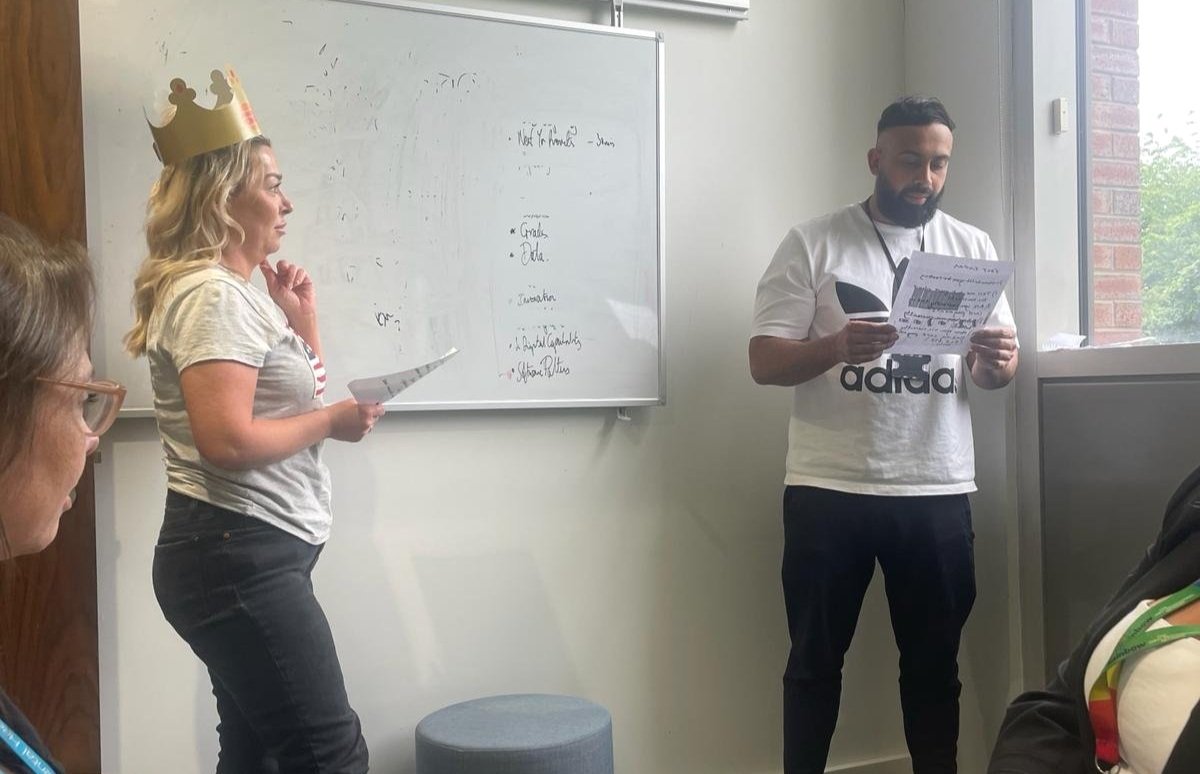
Role-playing- This was the last exercise to run through how it would look like if some of the solutions were implemented. Burger king crown symbolized the important user.
WORKSHOP 1
Team A consisted of people who had worked in that role for at least 1 year. We also asked our colleagues to fill out a form created by us, which gave us more insights into our customers and their needs as well as an insight into how successful applications are made. We successfully managed to get back a total of 18 completed forms over one week which highlighted the various reasons for drop-offs and what kind of customers were applying.
Team A knew of a lot of frustrations and errors, but as they had gotten used to them over the time that they were employed, they had found ways to walk around or eliminate certain points.
For example, they knew not to ask a “stock/inventory” question to a charity since they are based on raising money through donations, not through stock. Since they were so comfortable with the role, they were able to be less robotic in their approach and would come off as more friendly and helpful while on the phone.
Most of their complaints had to do with the order, wording of questions and irrelevant questions depending on the industry in the application. They also asked for a way to have a stronger decision tree and a better way of articulating the device, contract, value proposition and benefits.
This group was very confident and loud, happy to share their experiences. They were more light-hearted and it was clear that there was a particular leader who was outspoken, that every member always agreed with.
WORKSHOP 2
Team B consisted of people who had worked in that role for less than 1 year which meant that they were not as familiar with the flow of the application journey as Team A. They were strict to the book than Team A, and they never deviated from the script even if some questions did not relate to a customers industry. This resulted in a lot of calls coming off as robotic and not personable with the customer. There were long pieces of scripts that they recited each application, paired with long recordings (eg. terms and conditions) that needed to be played which meant a lot of customers dropping off at this time.
They had similar pain points as the first group but they also picked up on a lot of functionality errors and highlighted the absence of visual aids in the application, making it challenging to navigate the extensive information. They proposed incorporating visual elements like videos or images for clarity, and maybe one day allowing the customer to follow them through the flow of the call on their own screens.
They also suggested adding a calculator within the form to facilitate quick calculations during customer interactions. The computers and the programs are known for freezing when you try to open certain materials such as the calculator. On the other hand, they had tried to use their phone calculators which could be distressing if they don't have their phone on them or if it's not charged.
There was also some secure and private information requested at pages 9-10 which some individuals did not have on hand or have permission to share.
I came up with the user persona of Janet: a seasonal cafe owner. The type of businesses that apply for this segment of Cardnet have a turnover of less than £50,000. As a seasonal cafe owner, Janet manages to earn her money during peak times on the beach. Her audience is holiday makers and the community. She has specific needs that would be easy for a sales colleague to find a suitable quote. She would need one or two POS(Point of Sale) systems that are portable, tethered to ethernet or a mobile device and that allow smaller transactions.
USER PERSONA






USER JOURNEY MAPPING
The customer journey map above was the first iteration before the workshops were completed. Through the workshops, we were able to develop this map as more and more insights and frustrations to highlight were brought to our attention.
It was important to understand the customer’s journey in applying for Cardnet. By separating the steps of the call into 7 segments, it was easier to break down each section and think of some ways to improve it. Customer touchpoints helped us come to an understanding of the application process as a whole. A lot of consideration would have gone into choosing Lloyds Cardnet platform unless you already had an account with Lloyds. There were then two application processes that you had to go through in order to sign up to a contract.
STORYBOARDING
This storyboard showed the user journey of making an application to Cardnet. This was based on the user persona above of Janet, the cafe owner. I also included the emotions that Janet would have gone through at the bottom of each box. This storyboard helps to give a visualisation of what a customer goals and needs and what would need to do to receive a Cardnet contract and how this process would have made her feel.
HOW MIGHT WE?
We managed to come up with 3 questions using the "How might we" method for improving the application journey to achieve consistency. I took all of the solutions that were thought of and categorised them into one of the following three questions.
1) How might we customise conversation flow based on customer needs?
2) How might we create better interactions with customers for better onboarding
3) How might we quote quicker for customers to provide a smoother journey?
FEASABILITY MATRIX
We then organised all of the insights from the sticky notes from the two workshops and placed them in Figjam. We collaborated with the sales manager and the two stakeholders to make an affinity map. We discussed our reasoning for the decisions that we made and agreed on the categories as a group.
Separately, the service designer and I then placed most of the ideas into a feasibility matrix. Although there were no ideas that were of low feasibility and user value- “Hard slogs”, we were able to detect quite a lot of “Quick wins”. This included some points about changing the wording and order of some of the questions (which would not be too much of a hassle to do) and making the flow of conversation more personable, open and understanding.
SOLUTION
OUTCOME
We found that newer colleagues were more likely to voice a pain point or concern than the older colleagues, who had gotten used to a number of the errors within the journey. The newer colleagues were quiet and stuck strictly with the script while the older ones knew how to manoeuvre the applications and speak suitably to the different kinds of customers that they spoke to.
Impact and Feasibility Matrices were created in order to determine the most effective solutions, we evaluated ideas based on impact, feasibility, and value. This matrix guided our decision-making process. This formed small changes such as wording to deleting some pages and even full projects that would take more time and budget eg. things to do with data storage or creating visual walkthroughs.
We had several meetings with stakeholders, including developers and project managers, to discuss technical and budgetary feasibility and answer questions about implementing improvements.
Immediate Improvement
There was currently a 28% call drop-off rate, so we decided to focus on three high-value "quick wins." We tailored the application based on colleague feedback and testing, and introduced a character option within the form on relevant pages. We found by implementing our top 3 solutions:
1) Added a calculator function to the bottom right of the form
2) Deleted 4 (out of 16) pages from the form and condensed and simplified a lot of the questions and wording (thus also making it less robotic and excessive) and allowed our colleagues to “skip” past 2 pages that were industry-specific.
3) letting customers know what sensitive information would be needed for fraud and security at the beginning of the call, and implementing these steps earlier during the application form.
With these changes we reached an overall decline from start to completion by 3-4 minutes on average in the phone call duration in the 3 following months. This was calculated by looking at the average phone call length over before, during and after the three month period of making these changes. There was also a call drop-off rate improvement by 7% which was measure by identifying the rate of drop offs when the sensitive information was requested later on in the form as opposed to when we adjusted it so that it was present earlier in the form. As users were more prepared to answer the sensitive questions, there was a decline in drop offs at this specific part of the flow and therefore the overall journey flow.
PROJECT LEARNINGS
Range of users: The importance of speaking with as many user types as possible. By working with both teams, we were able to gain insights that we would have missed out on if we had stuck to working with one team.
Affinity mapping: The importance of affinity mapping and how great it works to clue in managers and stakeholders on the insights and learnings from the workshops. It allows a collaborative aspect between us and some interesting conversation about the placement of ideas and their categories.
Feasibility: Managing to sort through a mass of ideas into a feasibility or prioritisation matrix. This helps to figure out which points are the most important and would be the most impactful. Without these, you just have a lot of ideas and you don’t know where to start or how to order them.
All the users: That it is not always just about the end user. The purpose of the project was to make the lives of the customer-facing colleagues and the end users easier and more intuitive. Getting feedback from our colleagues was integral to taking on the complaints that users had been making by the horns.
If I were to do this again, I would have a third workshop that included members of both teams. I would like to see how they would react in a room together and if this would have brought more insights and ideas to them. I think it would have been valuable, however due to time constraints we were unable to do so.












